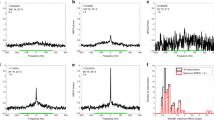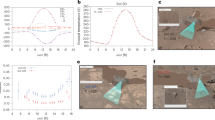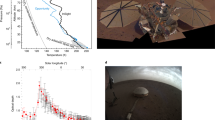Abstract
The surface of Saturn's largest satellite—Titan—is largely obscured by an optically thick atmospheric haze, and so its nature has been the subject of considerable speculation and discussion1. The Huygens probe entered Titan's atmosphere on 14 January 2005 and descended to the surface using a parachute system2. Here we report measurements made just above and on the surface of Titan by the Huygens Surface Science Package3,4. Acoustic sounding over the last 90 m above the surface reveals a relatively smooth, but not completely flat, surface surrounding the landing site. Penetrometry and accelerometry measurements during the probe impact event reveal that the surface was neither hard (like solid ice) nor very compressible (like a blanket of fluffy aerosol); rather, the Huygens probe landed on a relatively soft solid surface whose properties are analogous to wet clay, lightly packed snow and wet or dry sand. The probe settled gradually by a few millimetres after landing.
This is a preview of subscription content, access via your institution
Access options
Subscribe to this journal
Receive 51 print issues and online access
$199.00 per year
only $3.90 per issue
Buy this article
- Purchase on Springer Link
- Instant access to full article PDF
Prices may be subject to local taxes which are calculated during checkout



Similar content being viewed by others
References
Lorenz, R. D. & Lunine, J. I. Titan's surface before Cassini. Planet. Space Sci. 53, 557–576 (2005)
Lebreton, J.-P. et al. An overview of the descent and landing of the Huygens probe on Titan. Nature doi:10.1038/nature04347 (this issue)
Zarnecki, J. C. et al. in Huygens: Science, Payload and Mission (ed. Wilson, A.) 177–195 (SP-1177, ESA Publications Division, Noordwijk, The Netherlands, 1997)
Zarnecki, J. C., Leese, M. R., Garry, J. R. C., Ghafoor, N. & Hathi, B. Huygens' Surface Science Package. Space Sci. Rev. 104, 593–611 (2002)
Kömle, N. I., Kargl, G., Ball, A. J. & Lorenz, R. D. (eds) Penetrometry in the Solar System (Austrian Academy of Sciences Press, Vienna, 2001)
Lorenz, R. D. et al. An impact penetrometer for a landing spacecraft. Meas. Sci. Technol. 5, 1033–1041 (1994)
Fulchignoni, M. et al. In situ measurements of the physical characteristics of Titan's atmosphere. Nature doi:10.1038/nature04314 (this issue)
Tomasko, M. et al. Rain, winds and haze during the Huygens probe's descent to Titan's surface. Nature doi:10.1038/nature04126 (this issue)
Wentworth, C. K. A scale of grade and classification terms for clastic sediments. J. Geol. 30, 377–392 (1922)
Seiff, A. et al. Determination of physical properties of a planetary surface by measuring the deceleration of a probe upon impact: Application to Titan. Planet. Space Sci. 53, 594–600 (2005)
Lorenz, R. D. Huygens probe impact dynamics. ESA J. 18, 93–117 (1994)
Porco, C. C. et al. Imaging of Titan from the Cassini spacecraft. Nature 434, 159–168 (2005)
Elachi, C. et al. Cassini radar views the surface of Titan. Science 308, 970–974 (2005)
Sotin, C. et al. Release of volatiles from a possible cryovolcano from near-infrared imaging of Titan. Nature 435, 786–789 (2005)
Acknowledgements
We acknowledge the work of the SSP Team and the HASI Accelerometer Team both past and present in the design, build, test, calibration and operation of these experiments. This work has been funded by the UK Particle Physics and Astronomy Research Council, The Royal Society, the ESA, NASA, CNES and the Polish State Committee for Scientific Research.
Author information
Authors and Affiliations
Corresponding author
Ethics declarations
Competing interests
Reprints and permissions information is available at npg.nature.com/reprintsandpermissions. The authors declare no competing financial interests.
Rights and permissions
About this article
Cite this article
Zarnecki, J., Leese, M., Hathi, B. et al. A soft solid surface on Titan as revealed by the Huygens Surface Science Package. Nature 438, 792–795 (2005). https://doi.org/10.1038/nature04211
Received:
Accepted:
Published:
Issue Date:
DOI: https://doi.org/10.1038/nature04211
This article is cited by
Comments
By submitting a comment you agree to abide by our Terms and Community Guidelines. If you find something abusive or that does not comply with our terms or guidelines please flag it as inappropriate.



